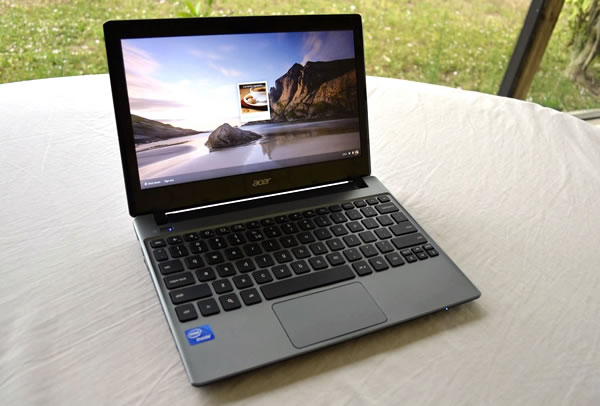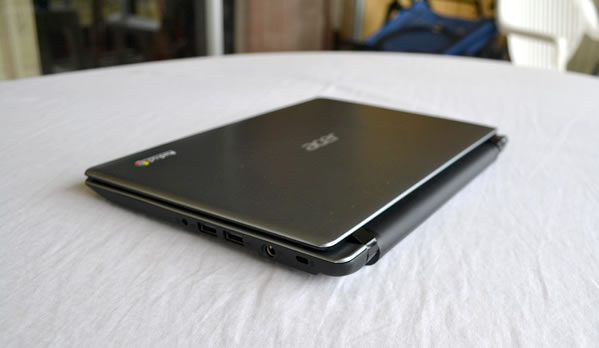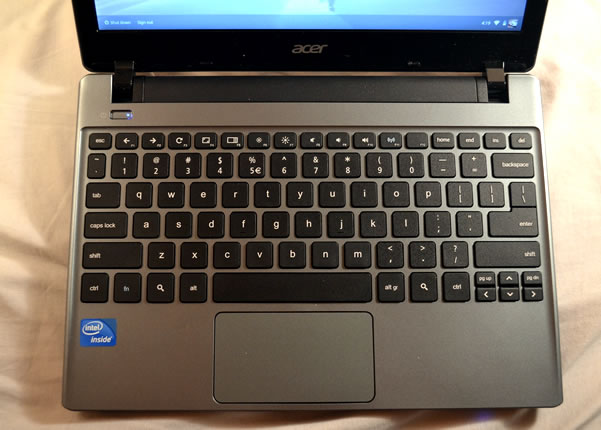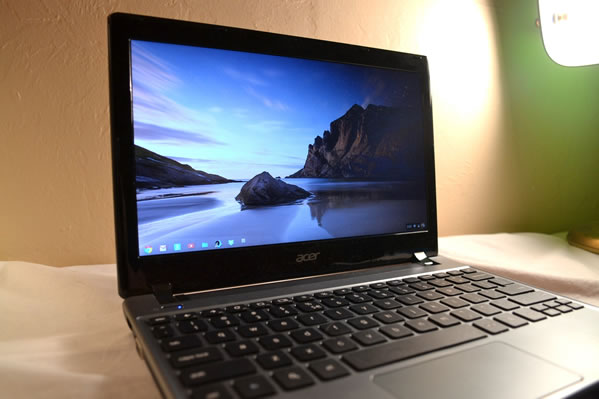A $200 laptop is a difficult thing to assess. On one hand, the Acer C7 Chromebook has that shockingly low price tag, on the other, there is weak build quality and a netbook-grade processor. The trade-offs the buyer must be willing to make are not trivial. And that's before we acknowledge that the Acer C7 runs Chrome OS rather than Windows.
The most interesting question then, is who exactly is the C7 for? Before we can get to who it's for (hint: there is more than one correct answer,) we have to get to the bottom of what the C7 is and then more importantly, what it can do.
Hardware
In terms of hardware, the C7 is a barebones affair though to be honest we didn't expect otherwise for the price. At exactly three pounds, the C7 is light but it doesn't feel compact. Since the entire machine is constructed of incredibly light (read: cheap) plastic, the battery at the rear of the machine contains the vast majority of the Chromebook's weight. This leaves the computer's heft feeling unbalanced toward the back and unwieldy when being toted around the house and pulled from a bag.

The gray-blue hue of the lid is the sharpest looking part of the laptop. It has a speckled shine to it. There's an off-white, silk-screened Acer logo in the middle and the Chrome logo badged along a top corner. The hinge that attaches it to the rest of the chassis is a gloss black. When pressed, it audibly pops in and out of place. It's much less than reassuring.

The bottom of the PC is black plastic with the speakers near the front. Speaking of, they're mostly terrible. The sound comes from the high ranges. There's a predictable absence of bass, and at loud volumes the sound becomes grating to the ear. Luckily, there's a perfectly serviceable headphone jack on the right side of the deck. Also on the right hand side is a pair of USB 2.0 ports, a Kensington Lock and the charging port. What's worth mentioning about the charger is that it has an impressively small power brick. It's slightly larger than the palm of my hand. On the left-hand side of the deck is a third USB 2.0 port and a few surprises. There is an Ethernet port, a full-size HDMI plug and a VGA port. The SD/MMC reader on front lip rounds out the port selection.

Opening the laptop reveals Acer's Chromebook's 11.6-inch, glossy screen. This is the only physical difference between the C7 and the many netbooks of yesteryear. The resolution clocks in at a predictable 1366x768 and a webcam sits exactly where you would expect it to. The screen waxes between decent sharpness and abysmal color reproduction on account of the enormous amount of light bleed on the panel. The 1366x768 resolution across 11.6-inches does manage to bring out a good deal of detail, but often times the images look washed out and devoid of color.
The deck is fitted with a full-size, chiclet-style keyboard. The keys are soft to the touch, a matte and slightly textured finish helps the fingers find their way. The only major differences between this keyboard and the one you are used to is the absence of the Windows key. Here, it is replaced with two keys, a function key and a dedicated search key. We will dig more into their functionality later. The keys feel okay. The travel is rather shallow, and some keys wiggle in their slots, leading to a few more typos than expected. It's a perfectly serviceable keyboard for day-to-day use, but it is nothing more than that.

The trackpad is very good. Sitting flush in the palm rest, the trackpad is parallel and equal in length to the space bar. It's plastic rather than glass, but its texture is pleasant and easy to work with. Google's particular gestures for Chrome OS all work well, which is more than can be said for many Windows laptops. Pointing around the desktop is as easy as it should be. Aside from occasionally desiring the trackpad to be a bit wider, there isn't anything to complain about.
The internals are solid for the price. A dual-core Intel Celeron clocks in at 1.1GHz, supported by 2GB of RAM and a 320GB HDD. The Celeron hums through Chrome OS, booting in between twenty and twenty-five seconds. The Chromebook gamely chugged through Bastion without complaint or much in the way of heat and noise. In fact, firing up ten different tabs in Chrome didn't seem to trouble the machine. Only one test perplexed the Chromebook. Loading photos from an SD card was nigh-impossible. The C7 would chug when opening the SD card, and then crash when I would scroll through the gridded list of photos. I repeated this action, with the same crashy results multiple times. Admittedly, the card was loaded to the gills with full-size DSLR shots, but a Windows machine would have taken its time, not made excuses and failed the task.

The C7's battery life was good for just under four hours under regular usage. That's less than four hours of browsing and word processing. This laptop runs on netbook internals, so in my book less than four hours is insufficient.
